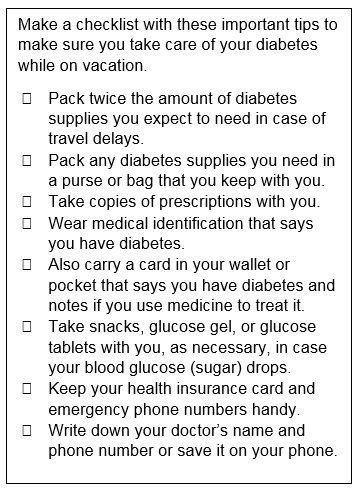Tips to Care for Your Diabetes While on Vacation

Are you counting the days until your vacation? Or are you just starting to plan one? As you get ready for your time away, make sure you plan ahead to take care of your diabetes.
Getting ready to travel
Before you leave, make sure you have everything that you need to take care of your diabetes. First, talk to your doctor about your vacation plans to learn what you need to do before, during, and after your trip. Things to think about and discuss:
-

Will you be more physically active or less active on your vacation? Ask your doctor about how your planned activities could affect your diabetes.
- Will you be walking a lot or going to the beach? Find out how to take care of your feet.
- When should you take your medicine if you change time zones?
- Will your meals be at different times from your usual schedule at home? Ask how this will affect your diabetes.
- How should you adjust your diabetes medicines based on your glucose (sugar) readings?
- Are your immunizations up to date? Do you need any special ones for where you’re going?
- Where can you get medical care if needed when away from home? What do you need to do to let your health insurance company know about your travel plans?
Take this article with you to the doctor to help you remember what to talk about.
Are you going on a road trip?
If you are traveling by car, you often have more control of the items you can take and have access to them at any time during your trip.
- Pack a small cooler with foods such as:
- Fresh fruit and sliced raw vegetables that may be difficult to find during your trip.
- Dried fruit, nuts, and seeds. Keep in mind that these foods can be high in calories, so measure out small portions (¼ cup) in advance.
- Don’t forget to take enough bottles of water or a large water container for the road.
- If you need to take insulin, don’t forget to include it in your bag. Don’t store insulin in direct sunlight or in a hot car. Put it in a cooler instead, but don’t place it directly on ice or on a gel pack as it may get damaged.
- Make sure you add a few stops throughout the trip to walk or move around every hour or two. This will help you reduce your risk for blood clots.
Are you traveling by plane?
- Keep in mind the hours you will spend in airports and the length of flights.
- Plan when and where you will get meals.
- If the airline serves a meal during your flight, you can call ahead to ask for a special diabetic, low fat, or low cholesterol meal. If they do not offer a special meal, you will need to bring a healthy meal or buy it separately. Take some snacks with you in case there are any delays.
- Plan to walk or at least get up and move between and during flights whenever possible to reduce your risk for blood clots.
- Be sure to pack all your medicines and diabetes supplies in your carry-on luggage, and keep them with you for easy access during the flight. If your carry-on luggage is checked at the gate, remove your medications and diabetes supplies and take them with you onto the plane.
Tips for airport security screening
- If you can, bring prescription labels for your medicines and medical devices. Although airport security doesn’t specifically require them, having them available may make the security process go more quickly.
- Put medicines and other diabetes supplies in your carry-on luggage and take them on the plane with you.
- Pack medications in a separate clear, re-sealable bag. Bags of medicines in your carry-on luggage need to be removed and separated from your other belongings for screening.
- If you use an insulin pump, you can be screened without disconnecting from the pump. Tell the officer conducting the screening about the pump before your start the screening process. You can be screened with advanced imaging technology (AIT), metal detectors, or thorough pat down.
- If you wear an insulin pump and continuous glucose monitor (CGM), you may go through the airport metal detector. It is not recommended you go through an airport scanner (AIT). If you disconnect your sensors for screening, do not send them through the baggage x-ray machine. Put them in a separate bag and show it to the screening officer. If you do not wish to disconnect your devices, you may ask for a pat-down screening. If you choose a full pat down, or if the officers say you need pat-down screening, you have a right to have this screening done in private and with a witness of your choice.
- You can get an information card about insulin pumps to show to the screener and get more information about airport screening and travelling with a pump and/or CGM from the manufacturer’s website.
These sites provide more information for safe travels with diabetes:
Have Diabetes? Get Tips for Safe Travels
Air Travel and Diabetes
Staying Healthy On the Go with Diabetes
- Page last reviewed: July 2, 2017
- Page last updated: July 2, 2017
- Content source:
- Maintained By:


 ShareCompartir
ShareCompartir